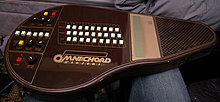music.wikisort.org - Instrument
The Omnichord is an electronic musical instrument introduced in 1981 by the Suzuki Musical Instrument Corporation.[1] It typically features a touch plate known as "SonicStrings", preset rhythms, auto-bass line functionality, and buttons for major, minor, and 7th chords. The most basic method of playing the instrument is to press the chord buttons and swipe the SonicStrings with a finger in imitation of strumming a stringed instrument. The SonicStrings may also be touched in one place to create a single note. Originally designed as an electronic Autoharp, the Omnichord has become popular, due to its unique, chiming, harplike timbre and its value as a kitsch object.
This article needs additional citations for verification. (April 2022) |
 Suzuki Omnichord OM-150 | |
| Other names | Q-chord |
|---|---|
| Classification | Electronic musical instrument, Synthesizer |
| Inventor(s) | Suzuki Musical Instrument Corporation |
| Developed | 1981 |
| Related instruments | |
| Tronichord, Autoharp, Keytar | |


The Omnichord and its prototypes, the Tronichord and Portachord (the latter two never reached full production) share many technical and functional similarities. Omnichords feature preset rhythms with a tempo and volume control, as well as an auto-bass line feature, actuated by a button, which the player may use as accompaniment. Several models of the Omnichord were produced that added MIDI compatibility, a selection of voices for the SonicStrings, vibrato, and chord memory. Some Omnichord musicians will play the instrument as a keytar, by strapping the instrument on both ends and playing it as if it were a Keytar.[citation needed]
The Omnichord is still produced by Suzuki, but rebadged as the Q-chord. It features more modern versions of the original Omnichord's features such as PCM sampled sounds, and more rhythms.[2]
See also
- Autoharp
- Tronichord
References
- Hills, Bruce (2 June 1982). "Device converts the musically illiterate into instant maestros". The Deseret News.
- Orensten, Evan (20 December 2007). "Suzuki Omnichord". Cool Hunting. Archived from the original on 7 September 2011. Retrieved 3 June 2011.
External links
Другой контент может иметь иную лицензию. Перед использованием материалов сайта WikiSort.org внимательно изучите правила лицензирования конкретных элементов наполнения сайта.
WikiSort.org - проект по пересортировке и дополнению контента Википедии